This article was taken from a talk given by Katie Smeal at the Customer Marketing Summit, hosted by our sister community the Product Marketing Alliance in September 2021. Since then, Katie has taken on a new role as Director of Customer Marketing and Advocacy at Outreach. Congratulations, Katie!
Hi there, I’m Katie Smeal and I'm a Senior Customer Advocacy Manager at DocuSign, where I’m helping to build and launch our new customer advocacy program. Before I joined DocuSign’s team, I was responsible for creating and launching VMware’s global customer advocacy community, which was a hugely exciting and rewarding challenge.
The beauty of building a customer advocacy community
I’m here today to talk about how we move away from the traditional transactional way of doing reference recruitment and start building a holistic customer advocacy community.
In the spirit of community, I thought I would start us off with a definition. If you look it up, community is “a feeling of fellowship with others as a result of sharing common attitudes, interests, and goals.” As human beings, we crave connections with others through shared stories and experiences – that's how we create a true community.
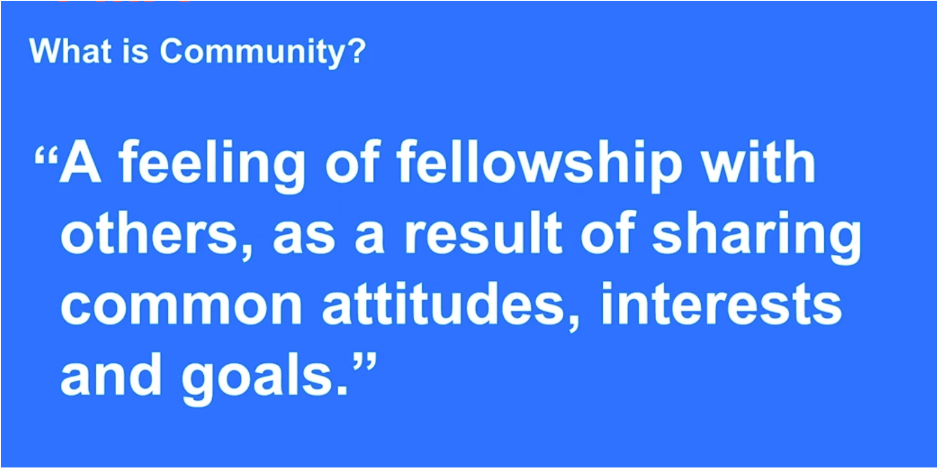
To create an engaging community experience for our customers, we have to look beyond the way that we've done things in the past and bring these special moments of togetherness to an online forum. There might be times when we can engage with our customers in person, but the majority of our connections with our customers will be online, so how do we bring these magical moments into an online community?
Before I get down to the nitty-gritty, I’d like to share a story that I think illustrates the beauty of a strong customer advocacy community.
A few years ago, my team and I were on-site at a conference after launching our online customer advocacy community. We were standing at our booth, watching our customer advocates engage with each other, exchange numbers, attend sessions together, and share stories. It was incredible to witness how a community within the tech space could truly come to life and the impact that it has on our customers.
I sat down to talk to one of our customer advocates, just to see how things were going for him personally and at work, and also to ask how we could make the community even better. This is what he said to me: “The IT world is a big place and it's easy to get lost. The future of technology is only going to move faster and faster. We must build and rely on a community of people and resources we trust to achieve our current and future goals.”
That was the moment when I realized the impact that we can have on our customers and our business by creating a community. I think about and reference this quote all the time as I'm realizing what is possible with a strong network of customer advocates.
I share this as a success story to inspire you, wherever you are in your journey from the traditional reference recruitment model to creating a holistic advocacy community for your customers.
Having a customer share the impact that your community has on them is the dream state, but it takes a lot of thoughtful work and planning to get there. So for those of you who are just at the beginning of your journey, you’re not alone. At DocuSign, we’re in the beginning stages of building a relational experience with our customers too. I’m going to share my experiences to make the transition a little easier.
Moving away from the traditional advocacy model
Throughout this article, I’ll share experiences that I've had building an online customer advocacy community. My hope in sharing these experiences is that you can identify where you are in your journey, and you'll feel empowered to take the next step towards building a community around customer advocates.
When I was first introduced to customer advocacy, it was thorough traditional transactional reference recruitment. We would reach out to our customers, provide them with an opportunity to share their story, help them bring this story to life, showcase it, and thank them. That would be the end of our communication. We typically wouldn’t reach out again until another referencing opportunity arose.
So what's wrong with that model? It's very transactional to start. I know I've used that word several times now, but it's true. How can we expect our customers to feel a connection and a commitment to our business if we're only reaching out when we want something from them?
When we gather in person, we don't just walk up to each other, exchange the bare necessities, and leave. We stay, we listen, and we connect with one another.
This is why building an online customer advocacy community that mirrors the feeling of meeting in person is so important. It gives our customers a dedicated space to share their stories, connect with each other, and connect with our business. In a relationship where we're both communicating consistently with each other and learning about one another beyond the sales transaction, customers get to feel a real sense of partnership with us.
Launching a customer advocacy community the right way
Before we go through the steps to launching a customer advocacy community, I just want to point out that it's really critical to first do a business assessment and identify all of the customer touchpoints within your business. From the moment your customers transact with sales, what does that journey look like? Knowing that and building a vision of what you want that experience to look like in the future will be invaluable as you build out your community.
Now without further ado, let’s look at those six steps to customer advocacy success.
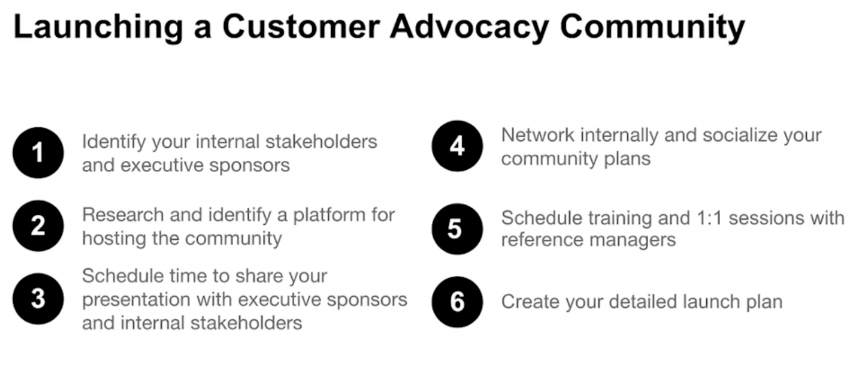
Step one: Identify your internal stakeholders and executive sponsors
As you take off on this adventure, it's important to first identify the other key players. Think about all the functions that your customer advocacy team supports – those will be really important stakeholders as you build out your community.
Take note of your executive sponsors too. They're going to be, for lack of a better word, your advocates through this journey; they’ll help you to get to the point of launching your customer advocacy community.
Step two: Research and identify a platform to host the community
Once you’ve identified your stakeholders, you'll want to find the right platform to host your community. At VMware, we partnered with Influitive; it was a great partnership, and we were able to accomplish a lot together. I would recommend really looking into what makes sense for your business and your overall goals and finding the platform that fits your criteria.
Step three: Schedule time to share your presentation with executive sponsors and internal stakeholders
Next, you want to build out a presentation about all the value your advocacy community and your chosen platform will bring to your business. Schedule some time to share your presentation with the executive sponsors and internal stakeholders you identified earlier.
It's really important not only to lay out the value of the platform but also what it looks like for the business. How is this customer advocacy community going to be of value to customer success, sales, marketing, PR, AR, and all of the internal groups that you interact with? Make sure that value is very clearly defined as you present it to your executive sponsors and internal stakeholders.
Step four: Network internally and socialize your community plans
When your community plan has been formalized, I encourage you to chat with your colleagues about it. Meet with different groups, including the ones that I just mentioned, and share your plans for your customer advocacy community. This is a great opportunity to get their feedback too.
Make all of your colleagues feel part of a village as you launch this advocacy community for your customer base. That way, when you go to launch, you're not in a place where people are wondering what you’re up to – you have a whole village supporting you because they see how your community is going to make a difference in the customer journey.
Step five: Schedule training and one-to-one sessions with reference managers
One group to pay particular attention to as you share your plan is your reference managers. Being a reference manager myself for many years now, we're used to the traditional transactional advocacy model I described earlier. We've been operating this way for so long that your community model is probably going to be a big change, and change can be hard.
I think it's vital to schedule one-on-one sessions to make sure that your reference managers see the value in engaging with their customers and nurturing relationships in this community. Make sure they have the opportunity to share feedback and they feel empowered to go into the community and engage with their customers in this new way.
Step six: Create your detailed launch plan
At the same time, you’ll want to be thinking about your launch plan. These are a few key steps that I would recommend you take, based on my experience.
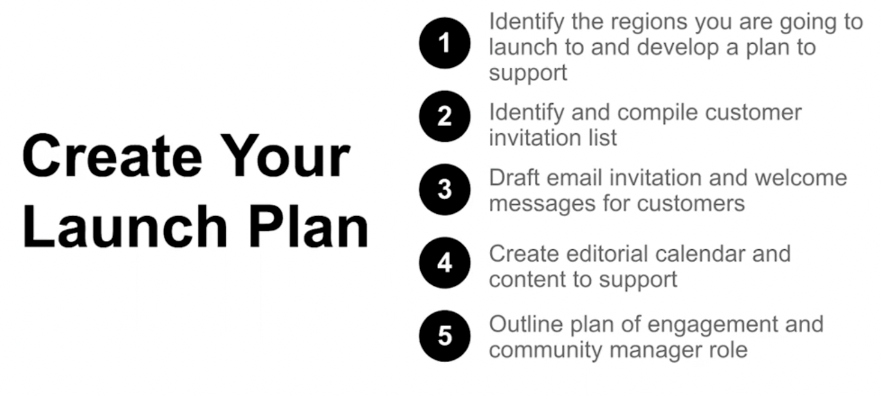
Identify the regions you’re going to launch to and develop a plan to support them
As you're looking at the different regions that you're rolling out to, you'll want to make sure that you identify the right way of engaging with them.
What's important in North America? What's the difference between engaging with the Middle East and the Asia Pacific region? Do your research so when you welcome these customer advocates into your community, they really feel welcomed and it's a customized experience for them.
Identify and compile a customer invitation list
From there, you'll want to identify a list of customers to invite. If you think of a typical party or gathering, oftentimes there are guests who are really excitable and keen to share, then there are quieter individuals who are there more to listen. It's a great idea to think about that in-person gathering, and bring that dynamic to life in your community.
You can do that by inviting existing customer advocates that you've already nurtured relationships with, and inviting new advocates so that they can interact with each other. Maybe those who you've known for some time will encourage your newer customer advocates to share their stories and network with each other.
Draft email invitations and welcome messages for customers
Once you’ve decided who to invite, it’s time to draft some email invitations and welcome messages. These should outline the value of your community so that your invitees want to join.
You can give your customers a guided journey into your community in these welcome messages, so that when they join, they know where to go.
Create an editorial calendar and content
Publishing content every single week and prior to launch will make you successful. What we did was create an editorial calendar; that way, we could be really thoughtful in planning our content ahead of time. You should also be flexible with your plans though and be open to new content ideas as they pop up.
Three to five pieces of content is a great place to start, but once you launch, make sure you have fresh content in the community each week.
If you only put out product announcements, your advocates will quickly lose interest, so vary what you publish. You can share company announcements; you can ask your advocates what their holiday plans are and if they’d be interested in sharing their stories. Try to find ways to elevate the customer voice and give them a chance to shine, whether that’s by enhancing their personal brand or professional brand.
Outline a plan of engagement and community manager role
You need to make sure you have someone dedicated to the community, so that every day when your advocates log in, they're being engaged with, and they have someone from your business who can answer their questions. This is how you nurture and develop relationships, and that’s why it’s key to outline a plan of engagement and a community manager role.
A great network of advocates
Once you’ve started building your community, you and your stakeholders will probably want to know that it’s fulfilling its purpose and that it was worth all the time and energy involved in its creation. So how can you gauge the success of your community? Well, if you have a great network of advocates, you’ll know that your plan is working.
Here are some of the signs that you have a great network of advocates:
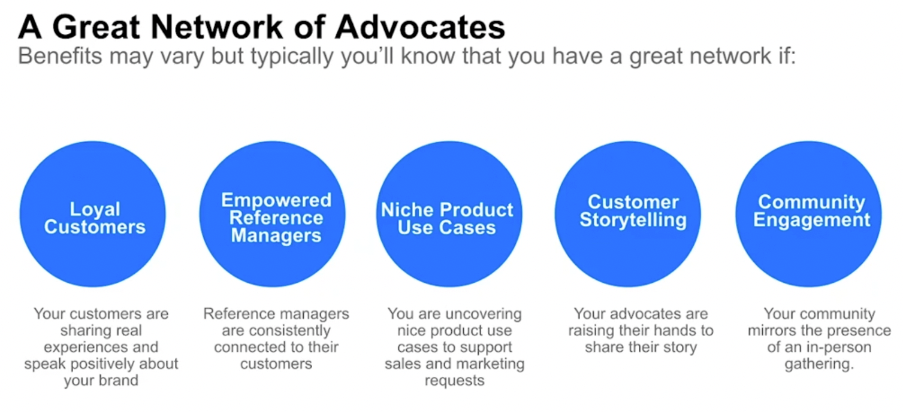
Loyal customers
First, no matter who your target audience is, start with your loyal customers. Maybe there are no issues with your product, but maybe there are. What matters is how your business and your customer advocacy team show up for your customers and solve their problems. Your loyal customers are the ones who, even if there have been some struggles, still speak positively about your brand whether you're in or out of the room.
Empowered reference managers
You’ll know you have empowered reference managers when they’re excited to jump into the community network with their customer advocates and nurture those relationships.
Niche product use cases
When you have a great network of advocates who are all sharing ideas and experiences in your product, you’ll naturally start uncovering niche product use cases. These use cases might also show up because a sales request comes in, and you’re supporting your sales colleagues by showing your advocates a new way to get value from your product.
Customer storytelling
Another sign that your community is doing what it set out to do is that you have customers raising their hands and wanting to share their stories. They might want to do a speaking session, or perhaps they’d rather talk one-on-one with other customers. Either way, it’s a customer marketer’s dream.
Community engagement
The final major sign that your community is working is that customers are actively engaging in it. If you have a discussion forum and users are not only responding to the prompts that the business puts out but creating their own topics, that’s fantastic. If you can look at your community and see that it mirrors the animation of an in-person gathering, you know you've done something really meaningful.
How to measure success and report ROI
Before I wrap up, let’s look at how to measure the success of your community and report ROI. I’ll talk you through some of the ways that we’ve approached this with the community that I’ve launched at DocuSign.
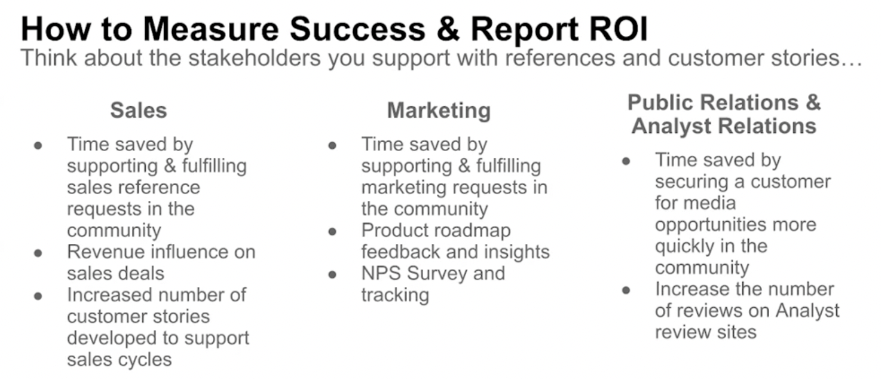
In customer advocacy, we support teams across the business with references and stories. Sales, marketing, public relations, and analyst relations in particular stand to benefit. With a great community, you can save all of these teams time by fulfilling requests more quickly. That’s a huge marker of the overall success of the customer advocacy team and the community you’ve built.
Take sales, for example. When a sales request comes in, we typically have a pretty short turnaround, but the request can take hours, days, or even a month to fulfill. However, if you put an opportunity to share stories to the community, within hours, you could have a huge network of advocates raising their hands and wanting to support you because they love your brand.
That's going to have a huge impact on sales. Fulfilling this reference request more quickly can ultimately help them close the deal faster, and then you’re driving revenue. What’s more, by supporting sales, you’re going to help create even more customer stories that can be used in the sales cycle when prospective customers want to hear from their peers about the success that they’ve had with your company.
Having a community of advocates who want to share their stories also means you can gather feedback and insights more easily and relay those results back to marketing. Your amazing new network of advocates is also going to boost your NPS, which, again, marketing can leverage to keep promoting your business.
Your community is also going to give public relations a boost by helping them to secure customers for media opportunities more quickly. These requests come in fast, and it’s going to be much easier to fulfill them when you have a ready-made pool of users who love your brand.
Lastly, you can use your platform to ask customers to leave reviews on analyst sites. This way, you’re both providing opportunities for your advocates to share their stories and driving analyst relations forward.
Final thoughts
I want to wrap up by thanking you all for sharing my journey with me. Customer marketing is a really exciting place to be right now and I’m delighted to be a part of it.
I hope that the experiences and tips that I've shared help you on your journey from transactional engagement with customers to building a holistic customer advocacy community.




